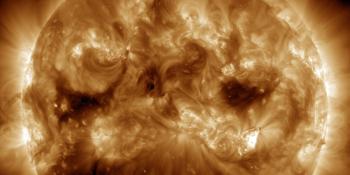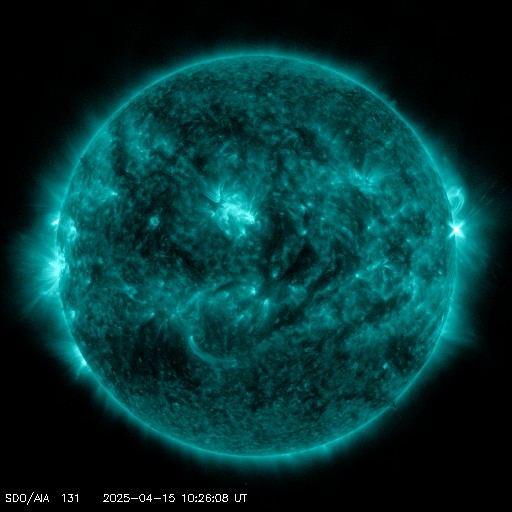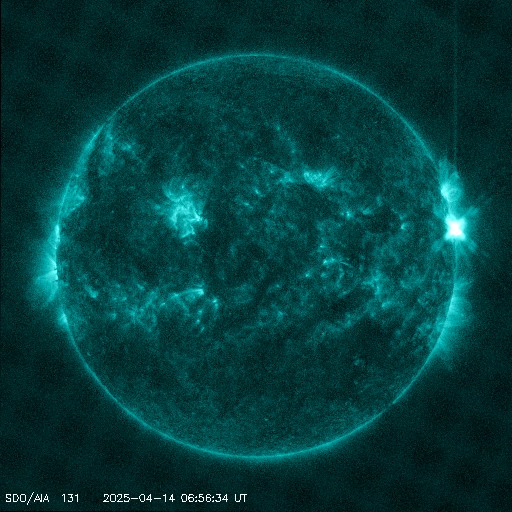Viewing archive of Monday, 14 January 2002
Solar activity report
Any mentioned solar flare in this report has a scaling factor applied by the Space Weather Prediction Center (SWPC). Because of the SWPC scaling factor, solar flares are reported as 42% smaller than for the science quality data. The scaling factor has been removed from our archived solar flare data to reflect the true physical units.
Report of Solar-Geophysical Activity 2002 Jan 14 2200 UTCPrepared by the NOAA © SWPC and processed by SpaceWeatherLive.com
Joint USAF/NOAA Report of Solar and Geophysical Activity
SDF Number 014 Issued at 2200Z on 14 Jan 2002IA. Analysis of Solar Active Regions and Activity from 13-2100Z to 14-2100Z
Solar activity has been moderate. The largest event of
the period was a long duration M4.4 flare, associated with an
evident CME from a source behind the southwest limb, at 14/0627 UTC.
M-class activity from regions on the visible disk included an M1/2n
from Region 9782 (N07E33) at 14/0156 UTC, and an M1/Sf from Region
9775 (S06W57) at 14/0136 UTC. The largest active region on the
visible disk, Region 9773 (N16W70), appears to be degrading somewhat
as it approaches the west limb, but maintains its moderate size and
magnetic complexity. Region 9782 and nearby Region 9785 (N11E41)
exhibited some increases in areal coverage and magnetic complexity
during the period.
IB. Solar Activity Forecast
Solar activity is expected to be low
to moderate for the next three days. Isolated major flare activity
is possible from the regions discussed in Section 1A above.
IIA. Geophysical Activity Summary 13-2100Z to 14-2100Z
The geomagnetic field was quiet to unsettled. High speed stream
effects from a favorably positioned coronal hole appeared to wane
with falling solar wind velocities over the course of the period.
Particle fluxes for >10MeV protons and >2MeV electrons were
enhanced, but remained below event thresholds.
IIB. Geophysical Activity Forecast
Geomagnetic field activity is
expected to be predominantly quiet to unsettled. Enhancements of
particle fluxes for >10MeV protons or >2MeV electrons could result
in above-threshold events during the period.
III. Event Probabilities 15 Jan to 17 Jan
| Class M | 75% | 75% | 75% |
| Class X | 20% | 20% | 15% |
| Proton | 30% | 20% | 15% |
| PCAF | yellow | ||
IV. Penticton 10.7 cm Flux
Observed 14 Jan 229 Predicted 15 Jan-17 Jan 235/240/240 90 Day Mean 14 Jan 224
V. Geomagnetic A Indices
Observed Afr/Ap 13 Jan 010/011 Estimated Afr/Ap 14 Jan 010/008 Predicted Afr/Ap 15 Jan-17 Jan 007/008-007/005-010/008
VI. Geomagnetic Activity Probabilities 15 Jan to 17 Jan
| A. Middle Latitudes | |||
|---|---|---|---|
| Active | 15% | 15% | 20% |
| Minor storm | 10% | 10% | 10% |
| Major-severe storm | 01% | 01% | 01% |
| B. High Latitudes | |||
|---|---|---|---|
| Active | 20% | 15% | 20% |
| Minor storm | 10% | 10% | 10% |
| Major-severe storm | 01% | 01% | 01% |
All times in UTC
Latest news
Latest forum messages
Incoming & Unnumbered Active Regions 1713AR4062 132025/04/12-13 Filament CMEs 2025/04/16 G2 Watch 60AR 4060 24AR 4062 1
More topicsSupport SpaceWeatherLive.com!
A lot of people come to SpaceWeatherLive to follow the Sun's activity or if there is aurora to be seen, but with more traffic comes higher server costs. Consider a donation if you enjoy SpaceWeatherLive so we can keep the website online!

Latest alerts
10:39 UTC - Solar flare
Moderate M1.52 flare from sunspot region 4055
10:24 UTC - Radio Blackout
Minor R1 radio blackout in progress (≥M1 - current: M1.52)
Monday, 14 April 2025
23:15 UTC - Geomagnetic activity
Active geomagnetic conditions (Kp4) Threshold Reached: 23:01 UTC
07:09 UTC - Solar flare
Moderate M4.28 flare from sunspot region 4055
06:48 UTC - Radio Blackout
Minor R1 radio blackout in progress (≥M1 - current: M1.53)
Space weather facts
| Last X-flare | 2025/03/28 | X1.1 |
| Last M-flare | 2025/04/14 | M4.2 |
| Last geomagnetic storm | 2025/04/06 | Kp5 (G1) |
| Spotless days | |
|---|---|
| Last spotless day | 2022/06/08 |
| Monthly mean Sunspot Number | |
|---|---|
| March 2025 | 134.2 -20.4 |
| April 2025 | 128.8 -5.4 |
| Last 30 days | 129.1 -15.1 |





